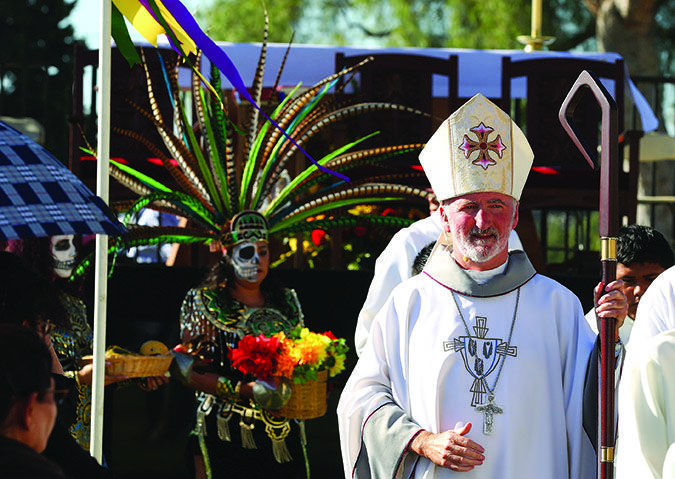On Nov. 1, families and friends gathered at Calvary Cemetery in East Los Angeles to pray for the souls of the dead and to celebrate their lives with food, music and dancing.
The celebration, Día de los Muertos (Day of the Dead), is the second-largest festivity in Mexican culture, says Lalo García, a renowned sacred artist and cultural consultant. His art was exhibited at the event.
“We come to celebrate the dead, but we also come to celebrate how they used to live their lives,” García says, adding that the most important Mexican cultural event is Our Lady of Guadalupe’s feast day on Dec. 12.
A Mass and procession preceded the day’s entertainment, which featured traditional dance, a two-hour mariachi concert and a live performance from the Latin Grammy-nominated group Trio Ellas. Families enjoyed the entertainment while eating together at tables that surrounded the stage.
Free food and beverages were provided, sponsored by Vallarta Markets, King Taco and El Gallo Giro of East L.A. Approximately 2,000 people were in attendance.
At the event, many children had their faces painted with the traditional embellished skeleton makeup. Another station was set up for children to design their own sugar skulls with brightly-colored paints. Participants were also able to make paper marigolds, the celebration’s traditional flower, which represents the fragility of life.
Catholic schools, businesses and other community organizations set up altars throughout the cemetery mausoleum. Candles, sugar skulls, crosses and pictures of the deceased adorned the altar displays.
Also incorporated in the displays were foods, drinks and items favored by the deceased while they were alive.
“In the altar we incorporate what the person loved; whether it is food or sports, we incorporate everything that they enjoyed into the altar,” says García. “We know that every evening of Nov. 1 we can come and visit our families in spirit, so they do not depart. It’s a visitor’s day.”
The mission friars who converted the first natives of California adapted the pre-Hispanic celebration to All Souls Day, García explains.
“The Day of the Dead is 2,000 years old, but they made the days coincide,” he says. “The fusion of Christianity and pre-Hispanic traditions is the beauty that you see now.”
García says that the celebration is significant to the Mexican culture because death is a reality that we all face. “What family doesn’t have a relative who has passed away?” The event allows people to understand and not fear death.
The skulls are made out of sugar for a reason, he says.
“In Mexico, you will find the sugar skulls are plain and when you come they will put your name on them. So you will grow up not being afraid of dying. So death is sweet.”
Death is just a passage, he says.
“At the time of death, you begin another life — an eternal and permanent life. Everything in this life is temporary. There are hundreds of songs and poems [in Mexican culture] that talk about how life is temporary,” Garcia added.
“It’s a way of teaching us as children not to be afraid of dying, because we will die.”
José Barrera, a 15-year-old student at Our Lady of Guadalupe School in Los Angeles, volunteered at the event. This year’s celebration has special significance for him after the passing of his grandmother, Aurora Barrera, a few months ago.
“She was hard working,” he says. “She was known for her generosity. Whenever someone needed money, she would help them.”
Her friends and family filled the church at her funeral. At home, he says, his family has set up an altar in her memory.
“We have pictures of her with all her kids and images of the Virgin Mary,” he says, adding that his family prefers to ornament the altar at home with crosses instead of skulls. “We don’t like skulls because it just reminds us that she has passed away.”
He said Nov. 1 is about “praying to [his] ancestors and telling them that [he] cares about them.” He adds that he wants his grandmother to know that he “loves her and wants her to rest well.”
The Catholic Cemeteries of the Archdiocese of Los Angeles hosted the festivities.

